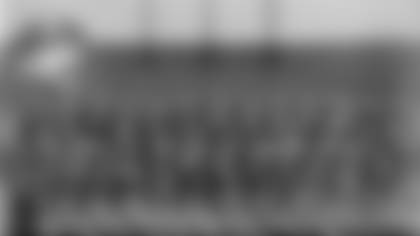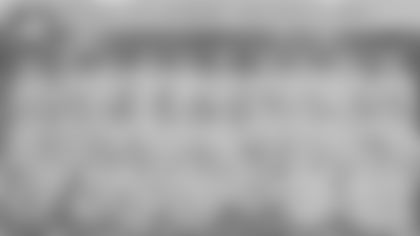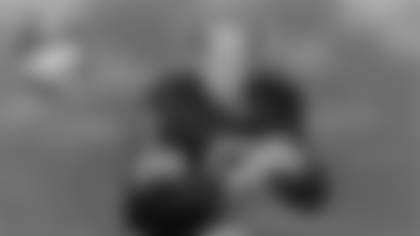Scott from St. Charles, IL
Have you ever thought of doing a story on Lombardi-era halfback Tom Moore? I was too young to have watched him play, but I heard about him and like many backup players, he doesn't seem to have a high profile. Looking at his stats, he didn't get much playing time except when Hornung was injured in 1962 and suspended in '63, but it sure looks like the guy could really run. He ripped off at least three really long runs, has a YPC figure just shy of Hornung's, and looked like a pretty good receiver and great kick returner, too. And, he was the No. 5 pick in the entire 1960 draft, so he must have had some talent. He even made the Pro Bowl one year! Was this a guy who just had the misfortune to play behind one of the most versatile halfbacks ever, or was there more to it?
Bill from Manitowoc asked the same question and wondered how Moore was acquired. First, I'll elaborate on that.
The entire 1960 NFL Draft was held on Nov. 30, 1959, in advance of the AFL's first season. By acquiring rights to college seniors in late November, they could sign those players who had already completed their season and at least make contact with those who still had bowl games to play.
The AFL held its draft a week earlier, and Moore was selected by the Dallas Texans (now the Kansas City Chiefs). Meanwhile, the Packers had played Detroit on Thanksgiving, four days before the NFL Draft. Thus, Vince Lombardi, defensive assistant Phil Bengtson and talent scout Jack Vainisi were able to leave for Philadelphia on Friday afternoon. The draft was scheduled to start at 9 a.m. (EST) Monday morning. That same day, after having Sunday off, Packers players and other staff members flew to Los Angeles to prepare for their next game against the Rams.
This was Lombardi's first draft as coach and general manager of the Packers. When the last 26 rounds of the 1959 draft were held (on Jan. 21, 1959), Lombardi was still an assistant with the New York Giants. This also was Jack Vainisi's final draft as a Packers scout. He would die Nov. 27, 1960, a month before the 1961 draft.
Shortly before the draft, Vainisi explained that the Packers were operating under a new system under Lombardi, where there was more staff involvement, although Lombardi would have the final say on the selections.
Vainisi said he, Lombardi, all four assistant coaches – Bill Austin, Red Cochran, Norb Hecker and Bengtson – and business manager Verne Lewellen had graded each prospect in advance. He further explained that Lewellen and the assistant coaches had gone to a number of college games on Saturdays that fall to scout players in person, while he – with Lewellen's help – spent his time in the office, studying reports filed by the Packers' vast network of college assistants, Packers alumni and others throughout the season.
"The draft under coach Lombardi is a complete, 100 percent staff effort…," said Vainisi. "It's almost like a vote and no one man, as in the past, makes a complete decision on a prospect's value."
The first four picks in the draft were: No. 1, LSU halfback and Heisman Trophy winner Billy Cannon by the Rams; No. 2, Notre Dame quarterback George Izo by the St. Louis Cardinals; No. 3, LSU's other halfback and a prospect as a defensive back in those days of one-platoon college football, Johnny Robinson, by Detroit; and No. 4, Penn State quarterback Richie Lucas by Washington. As it turned out, Cannon, Robinson and Lucas signed with AFL teams; and Izo was a bust.
In all, six of the 12 No. 1 picks signed in the AFL, including the first round's two future Pro Football Hall of Famers: Robinson as a safety and tackle Ron Mix of the Chargers. Of the six who signed with the NFL, Moore, linebacker Jim Houston of Cleveland and tight end Monty Stickles of San Francisco had the best pro careers, although as you pointed out, Moore got less playing time because he spent most of his time backing up Hornung, as well as Jim Taylor.
That said, Moore was often referred to by teammates and opponents alike as the best reserve back in the NFL. "I think he would have been a first-stringer with anybody else," Cochran, Moore's backfield coach with the Packers, told me in 2002. "Excellent hands. He took Taylor's place at times. He could block. He was a good ball-carrier."
Moore possessed all of the traits Lombardi wanted in a back. He was big and powerful and fast enough as a halfback to run the power sweep at 6-foot-2, 212 pounds. In addition, he was a good blocker and receiver. Moore broke Vanderbilt's single-season rushing record as a senior and was named all-SEC by the Associated Press. He capped his college career with 107 yards rushing, plus an interception and fumble recovery on defense, in a 14-0 upset of Tennessee as Vanderbilt finished 5-3-2, a record that wouldn't be topped at the school for 15 years.
Most important to the Packers, no doubt, was the glowing scouting report filed by Baby Ray, a 1940s all-decade tackle for the Packers and line coach at Vanderbilt at the time. He was one of the Packers' "bird-dogs" – the coaches and alumni who were paid to file reports on players before there were area scouts – and would be hired as a Packers fulltime scout in 1971.
"Best player we have had since I've been here," Ray, who had been coaching at Vanderbilt for more than a decade, wrote on his report to the Packers dated Nov. 16, 1959. Other descriptions in Ray's report included "real smart runner," "great balance," "tuff," "coachable," "real good competitor." Ray ended his report this way: "This Boy is a Real Blue Chip – This boy has never been out of action in 4 years here!"
Ray also wrote that Rams scout Eddie Kotal had told him they were thinking of taking Moore with the No. 1 overall pick. Kotal had been an assistant coach in Green Bay when Ray played there.
To this day, Moore and quarterback Bill Wade, the first overall choice in 1952, are the only Vanderbilt players ever taken among the top five picks in the draft. Three days after the draft, Lombardi announced Moore's signing.
As a rookie, Moore carried 45 times for a 5.3 average, better than Taylor and Hornung, and averaged 33.1 yards to lead the NFL in kickoff returns. In Moore's first extended duty after Taylor was sidelined with an injury in the sixth game, he took over at fullback and rushed for 105 yards in 11 carries, including a 59-yard touchdown run. He also returned a kickoff that year 84 yards.
Before the 1961 season, the Packers drafted Herb Adderley No. 1 with the intention of using him as a Lenny Moore type halfback-flanker. Lombardi, in turn, spent the offseason contemplating a return to the three-back set that he used in New York. "We have three great running backs in Moore, Taylor and Hornung," Lombardi said in mid-March. "Tom Moore figures real big in our plans." However, two days before camp opened, Lombardi announced he was scrapping his three-back idea.
That season, with Hornung unable to practice from about midseason on because of his Army duty, Moore saw extended action at times and again finished with impressive averages: 5.0 on 61 rushing attempts and 27.3 on kickoff returns.
In 1962, Hornung injured his knee in the fifth game and, thereafter, Moore got most of the playing time at halfback. While his averages were down, he had his best games when he played the most. He rushed for 84 yards on 14 carries in his first start, scored the game-winning touchdown in the fourth quarter of a 17-13 victory over Baltimore, scored two TDs including a 32-yard run in a victory over San Francisco and threw a 45-yard option pass for a TD in a 20-17 win over the Rams in the final regular-season game. That also was the year that Moore was selected for the Pro Bowl.
In 1963, with Hornung suspended, Moore finished second to Taylor in rushing with 658 yards, averaging 5 per carry; finished fourth in receiving with 23 catches and a 10.3 average; and completed three of four option passes for 99 yards and a touchdown. That also was the season that he capped with a 99-yard pass reception in what was commonly referred to as the Runner-up bowl.
In 1964, Moore mostly backed up Hornung and Taylor again, but he never got more than 12 carries a game, and Lombardi also started giving fourth-year veteran Elijah Pitts more playing time. Interestingly, according to Moore, he played fullback in place of Taylor, but he was always the halfback and Taylor the fullback when they were in the game together.
Still, Moore had been a reliable and productive third back. He ranked ninth all-time in team rushing. He had three 100-yard rushing days to his credit, including a 159-yard effort against Minnesota in 1961. He had averaged 26.5 yards on 71 kickoff returns. He also had completed 10 of 16 halfback option passes for an average of 26.1 yards per pass and four TDs, although he wasn't as fluid and deceptive at it as Hornung.
Perhaps most impressive was Moore's number of big plays for the amount of playing time he had received. According to Packers stats guru Eric Goska, Moore had nine kickoff returns of 40 yards or more, a number exceeded to this day only by Al Carmichael (13) and Adderley (10) since kickoffs were first tracked by the NFL in 1941. Moore also had three runs from scrimmage of more than 50 yards, a number topped by only five Packers since 1941: Ahman Green (8), Aaron Jones (6), Ryan Grant (5), Hornung (4) and Taylor (4).
The end for Moore came in 1965. With Hornung once again missing considerable time from midseason on with injuries, Moore lost his backup role to Pitts following a foot injury. Moore filled in for Hornung in a big win over Baltimore in the second game, rushing for 66 yards on 17 carries.
Thereafter, Moore carried 34 times for 58 yards.
He injured his foot and years later suspected it was a stress fracture. Back in 1965, doctors were puzzled by the injury and it would be another 10 years before the first MRI on a human patient was performed. "When (I) tried to run, cut and turn corners, it was like somebody was trying to stab you in the foot," Moore said in a 2003 interview.
Pat Peppler, the Packers' personnel director at the time, knew Moore's days were numbered when he heard Lombardi bark at him, "Damn it, every time I want you, you're hurt.'" Moore knew it, too. "…you were useless if you couldn't perform," he said. "That was the atmosphere."
Almost 10 months before the 1965 season, Lombardi had drafted halfback Donny Anderson as a future. Then in November 1965, Lombardi selected fullback Jim Grabowski in the first round of the '66 draft. As expected, Moore was traded and played two more years with the Rams and Atlanta but never fully recovered and never got his speed back.
Rich from Dayton, OH
I have enjoyed reading your columns, etc. for over 30 years. So glad you're continuing your life's work as part of the Packers organization. Do you think that Bob Harlan has the credentials for serious consideration for the Pro Football Hall of Fame? In my humble opinion, I'd make the case that he was the most important "Packer" of the past 30 years considering his hiring of and granting of complete authority over the football operations to Ron Wolf and also his leadership that led to the 1997 stock sale and the substantial improvement and expansion of Lambeau Field. Green Bay has had an unparalleled run of success for the past 30 years, for which Mr. Harlan deserves much of the credit.
Thanks for being a loyal reader, and I couldn't agree with you more about Harlan's impact on the Packers. Mike from De Pere wondered the same thing. As backdrop, I reported on the Packers for most of the 24 years of misery between 1968 and '91, and once wrote that the organization was so ineptly run that it had become a victim of its own inertia.
Thus, I don't think there's any question but that the resurrection of the franchise under Harlan's watch was one of the most remarkable turnabouts in NFL history. But I also must admit that I had no quarrel with the Hall of Fame first recognizing Brett Favre and Wolf for the Packers' rebirth. Plus, I believe Mike Holmgren is a worthy candidate as a coach.
That raises the question: What's the cutoff point? I consider Dallas' triumvirate of Tex Schramm, Tom Landry and Gil Brandt to be excessive for a franchise that over a 29-year period from 1960-88 won only two NFL championships. I'd also argue that the Cowboys' bigwigs had it easier starting out as an expansion franchise than Harlan and his staff did when they took over a franchise that had wallowed in mediocrity for almost a quarter-century.
Here's a question I'd raise: Should Harlan's legacy be viewed not just in the context of the NFL, but as part of a much bigger picture, that of corporate America? I'm stepping out of my sphere of knowledge here, but how many corporate leaders since World War II other than Lee Iacocca with the Chrysler Corporation have rescued companies on the verge of ruin, especially in such a high-profile business?
Viewing Harlan's achievements through that lens of history would enhance his case, I believe.
David from Fort Wayne, IN
What's the actual "official" birthday of the Packers? I keep finding different dates. Even the Packers' website has conflicting information.
The link you sent at our website is no longer active. We've made a number of corrections to our timeline and early history over the last several years, and I believe that was one of them. But just to clarify. August 11 has been recognized as the Packers' official birthday forever or since the first organizational meeting was held on that date in 1919 on the second floor of the old Green Bay Press-Gazette building on Cherry Street in downtown Green Bay. The Press-Gazette reported on the meeting two days later, although it didn't reveal how many people were there or name any attendees. A second meeting was held on Aug. 14 and close to 25 candidates for the new team were on hand. It was at that meeting when Curly Lambeau was elected captain and George Calhoun, sports booster and city editor of the Press-Gazette, was named manager.















